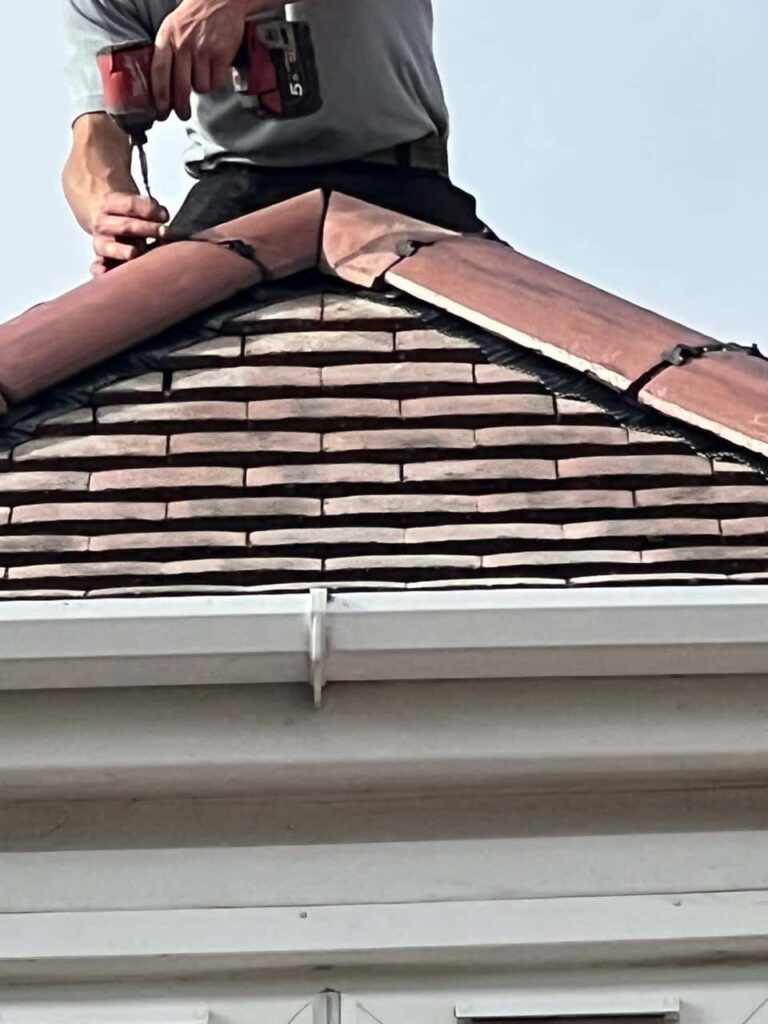Gable end roofs are a popular design across the UK, recognised for their classic triangular shape and excellent water drainage. However, while they offer practical and aesthetic benefits, they can also be more prone to wind damage, particularly during severe weather. At North Hykeham Roofing Repairs, we’ve seen how strong winds common in North Hykeham, Lincolnshire can impact gable end roofs and why professional maintenance and reinforcement are essential for their long-term stability.
Understanding the Structure of a Gable End Roof
A gable end roof consists of two sloping sides that meet at a central ridge, forming a vertical triangular wall at each end known as the gable. This design is efficient for shedding rain and snow, making it a popular choice for British homes. However, the same vertical gable wall that gives the roof its distinct shape can also create a weak point when exposed to strong winds.
Key Structural Features
- Two sloping roof sections meeting at a ridge
- Vertical gable walls on either end of the building
- Open eaves or overhanging sections that catch wind
While the design is straightforward and cost-effective to construct, it’s also more exposed to certain weather conditions that affect its resilience.
How Wind Pressure Affects Gable End Roofs
When strong winds strike a gable end roof, the vertical wall faces the full force of the wind, creating high-pressure zones that can lead to damage. The uplift effect caused by wind moving over the roof surface can loosen tiles, ridge caps, or even structural elements if not properly reinforced.
Common Effects of Strong Winds
- Increased Uplift: The wind can get under the edges of roof tiles or slates, prying them upwards.
- Gable Wall Strain: The gable end acts like a sail, absorbing direct wind pressure that can loosen bricks or render.
- Rafter and Truss Stress: Sudden gusts may create vibrations and movement in the roof structure, especially if fixings are old or corroded.
- Ridge and Verge Damage: Open verges and ridge tiles are particularly vulnerable to wind-driven rain and gusts.
This combination of direct wind pressure and uplift can make gable end roofs more susceptible than hipped or other roof types that deflect wind more effectively.
Why Gable End Roofs Need Extra Attention in Windy Areas
In areas like North Hykeham, where strong winds and storms are not uncommon, the design of a gable roof requires additional consideration. At North Hykeham Roofing Repairs, we often recommend reinforcement techniques and regular inspections to maintain the structural integrity of these roofs.
Key Reinforcement Techniques
- Secure Fixings: Ensuring ridge and verge tiles are firmly fixed using modern systems designed to resist uplift.
- Bracing Support: Installing internal bracing to strengthen the gable wall against lateral wind forces.
- Wind-Resistant Materials: Using quality adhesives, fixings, and underlays that perform well under high-pressure conditions.
- Regular Roof Inspections: Identifying small issues, such as loose tiles or mortar cracks, before they escalate during a storm.
These proactive measures can prevent costly damage and help maintain the roof’s resilience throughout the year.
The Importance of Professional Assessment
A professional roofer understands how to evaluate the full extent of wind exposure and identify weaknesses that may not be visible from ground level. At North Hykeham Roofing Repairs, we conduct thorough inspections that assess not just the surface but also the underlying structure, fixings, and weatherproofing details that contribute to long-term stability.
Professional Assessments Focus On:
- The condition of the gable wall and verge
- The security of ridge and hip tiles
- The integrity of fixings and trusses
- The overall wind resistance of the roof system
By addressing these factors early, homeowners can reduce the risk of structural issues and water ingress caused by wind-driven rain.
Preventative Maintenance for Wind-Exposed Roofs
Preventative care plays a major role in protecting gable end roofs. Simple maintenance actions can make a significant difference when carried out by experienced roofers.
Recommended maintenance includes:
- Checking verge mortar and tiles after strong winds
- Clearing gutters and downpipes to prevent water pressure buildup
- Repointing or resealing gable ends where necessary
- Inspecting roof fixings and replacing any corroded components
Consistent upkeep helps ensure that even during heavy wind events, the roof remains secure and weatherproof.
Conclusion
While gable end roofs are a popular and practical choice for many UK homes, their design makes them naturally more exposed to the effects of strong winds. With proper reinforcement, regular inspections, and professional maintenance, homeowners can significantly reduce the risk of damage and prolong the lifespan of their roofs. For expert support, North Hykeham Roofing Repairs offers reliable solutions to ensure that gable end roofs in North Hykeham remain strong, stable, and ready to withstand the changing British weather.
Call us on: 01522 302 298
Click here to find out more about North Hykeham Roofing Repairs
Click here to complete our contact form and see how we can help with your roofing needs.

